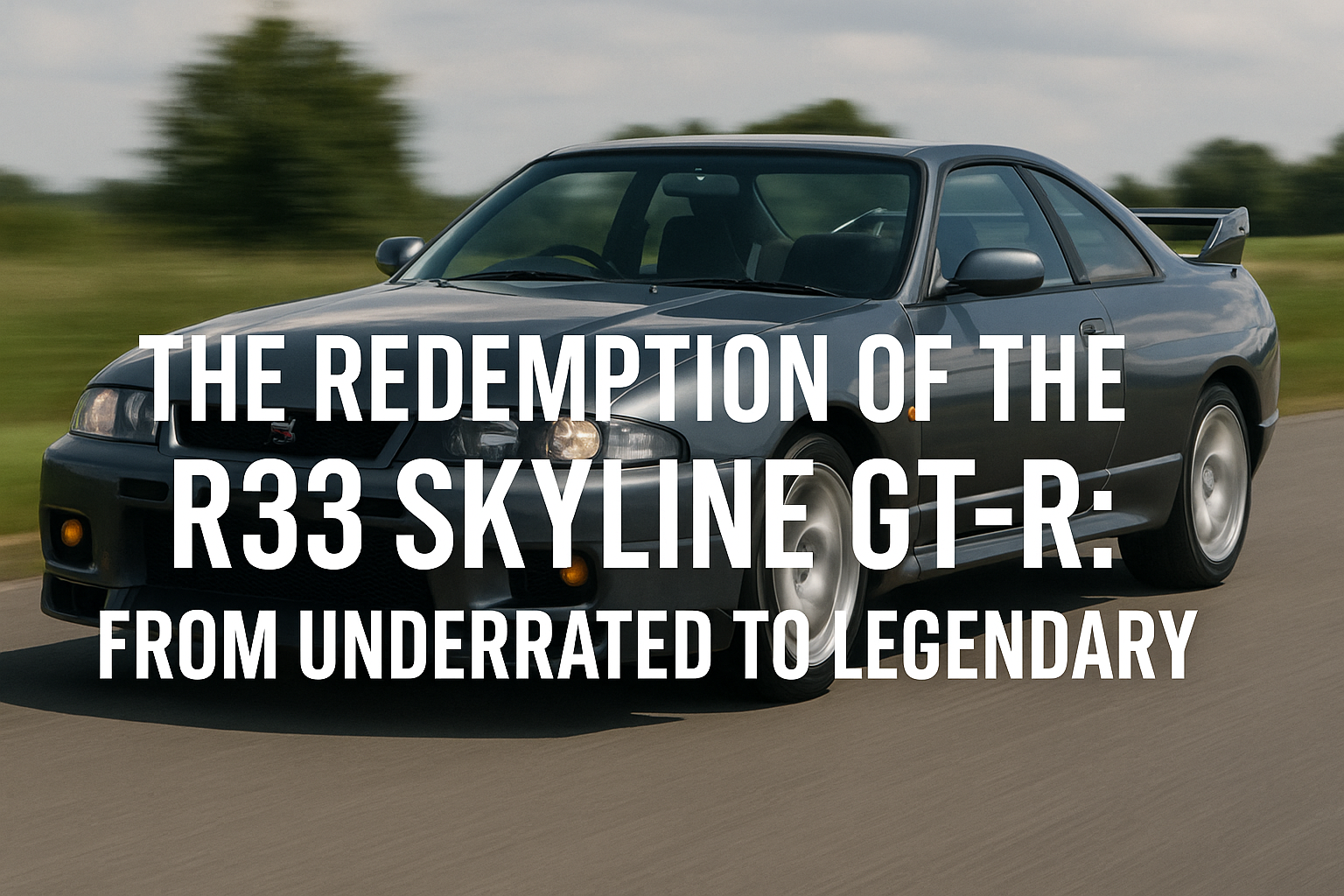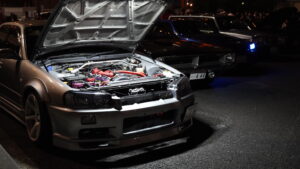Introduction
In the landscape of Japan’s sports car scene in the 1990s, few names inspired as much awe and reverence as the Nissan Skyline GT-R. Among them, the fourth-generation R33 Skyline GT-R (chassis code BCNR33), launched in January 1995, has always carried a peculiar duality—it was heralded with the legendary catchphrase “Minus 21 Seconds of Romance,” yet simultaneously branded by enthusiasts as “bloated” or “the disappointing GT-R.” For years, it remained the “shadowed hero” of the GT-R lineage.
However, time has revealed that the R33 GT-R was not merely a bulkier successor to the R32; it represented a major step forward in refinement, chassis rigidity, aerodynamics, and all-round performance. It proved its worth on the most demanding track in the world—the Nürburgring Nordschleife—where it shattered the R32’s lap time by 21 seconds, cementing the credibility of its evocative slogan.
In this feature, we’ll explore the R33 GT-R in depth—from its development background and engineering advances to its motorsport record, limited editions, market trends, and modern-day reappraisal. What caused the disappointment that clouded its debut? And why is it now being rediscovered as one of the most misunderstood yet rewarding GT-Rs ever made?
By revisiting the R33’s journey, readers will gain a richer understanding of how this once-overlooked icon is finally receiving the recognition it deserves as a genuine bridge between the analog might of the R32 and the digital precision of the R34.
1. Development Background and Concept
1.1 The R32 GT-R’s Triumph and Its Challenges
The R32 GT-R (1989–1994) dominated Japanese touring car racing, earning the nickname “Godzilla.” Yet its tight cabin, short wheelbase, and utilitarian comfort levels left room for improvement. Nissan engineers aimed for a successor that would preserve the GT-R’s racing DNA while improving everyday usability.
1.2 Designing the R33: Balancing Comfort and Control
The base R33 Skyline sedan grew into a larger 3-number body class. Consequently, the GT-R’s wheelbase was extended by 105 mm, addressing rear-seat space without compromising handling. Development began in 1992 under the theme “faster, safer, and more mature.”
1.3 “Burn the Retreat” — An Engineer’s Resolve
Chief engineer Kozo Watanabe famously declared, “Let’s build this car with no way back.” Despite weight gain, his team improved rigidity and integrated advanced materials to ensure the R33 would perform beyond expectations.
2. Engineering and Specifications
2.1 Powertrain and Drivetrain
The R33 retained the iconic RB26DETT 2.6-liter twin-turbo straight-six, rated at 280 PS and 37.5 kg-m of torque. The ATTESA E-TS all-wheel-drive system returned, while V-Spec models received an evolved E-TS Pro with active LSD for sharper cornering control.
2.2 Chassis and Dimensions
Dimensions: 4,675 mm (L) × 1,780 mm (W) × 1,360 mm (H); wheelbase 2,720 mm; weight approx. 1,530 kg—around 100 kg heavier than its predecessor. Though criticized for this gain, Nissan offset it through extensive reinforcements and weight savings in key areas.
2.3 Suspension and Braking
Both ends employed multi-link suspension. Brembo brakes were standard, with V-Spec models adding computer-controlled traction and LSD systems to improve response on uneven surfaces and under hard braking.
3. Comparing to the R32 and the Image Gap
3.1 Bigger Body, Different Feel
Fans accustomed to the R32’s raw, compact character felt the R33’s extended wheelbase and calmer chassis made it less “agile.” Many commentators dubbed it “the fat GT-R.”
3.2 Sales Struggles and Perception
Initial sales were steady, but dropped sharply after launch. By its final model year (1998), only 1,175 units were registered in Japan compared to 7,645 R32s in their last year — a telling indicator of the enthusiast mood.
3.3 “Minus 21 Seconds of Romance” — Fact or Myth?
On the Nordschleife, the R33 proved its engineering worth by lapping 21 seconds faster than the R32, clocking 7:59.887. Critics questioned whether a “press-tuned” car set the record, but the achievement remains a milestone for Nissan development standards.
4. Motorsport and Special Variants
4.1 Le Mans GT1 Challenge
Nissan entered the R33 GT-R LM in the 1995 24 Hours of Le Mans GT1 class. The engine was stroked to 2.8 liters and converted to a dry-sump setup, with lower mounting to improve balance. Though results were modest, it cemented GT-R’s international presence.
4.2 LM Limited and NISMO 400R
To commemorate the Le Mans effort, Nissan released the “LM Limited,” followed by the NISMO 400R—an extreme 55-unit variant with a 400 PS RB-X GT2 engine and wide-body aerodynamics. These editions epitomized the R33’s potential.
4.3 Track Performance Legacy
Despite lukewarm public sentiment, the R33 proved formidable in private time attack events and tuning circles, laying groundwork for the R34’s success.
5. Market Performance and Used Car Evolution
5.1 Sales and Post-Production Life
Launched in 1995 and discontinued in December 1998, the R33 saw moderate sales followed by steep decline. After production ended, it did not immediately rise in the used-car market, remaining an “affordable GT-R.”
5.2 A Symbol in Cinema: Villain (2010)
In Lee Sang-il’s film Villain (Akunin), actor Satoshi Tsumabuki’s character drives a white R33 GT-R—a subtle nod to how even a working-class man could own such a car at the time. It was a metaphor for raw talent beneath an unpolished exterior.
5.3 The “25-Year Rule” and Global Demand
With the U.S. import ban lifting in 2020 under the 25-year rule, global interest soared. Enthusiasts in North America and Europe began seeking well-preserved examples.
5.4 Surging Prices
Average prices rose from around ¥4.4 million (2020) to ¥6.8 million (2022) and ¥7.2 million in early 2023. Pristine or limited models now fetch over ¥15 million in Japan.
6. Reappraisal: From “Fat GT-R” to “Underrated Legend”
6.1 Why It Was Misunderstood
The R33’s broader stance and heavier feel clashed with the R32’s raw edge, leading fans to label it uninspiring. But its stability and balance were in fact superior for real-world driving.
6.2 Overshadowed by the R34
When the R34 arrived in 1999 with refined styling and tech, the R33 was quickly forgotten. Its “in-between” status masked how much it had advanced the platform’s aerodynamics and chassis technology.
6.3 Modern Reevaluation
Today, collectors and enthusiasts see the R33 as the hidden gem of the GT-R family. It embodies a transitional era—bridging analog power and digital precision—with a subtle charm that aged gracefully.
7. Future Outlook and Ownership Perspective
7.1 Investment Potential
As export eligibility expands, values are likely to continue rising. Well-kept V-Spec and LM/400R editions represent both emotional and financial investment opportunities.
7.2 Ownership and Maintenance
For owners, preserving original spec or period-correct modifications adds value. Suspension wear and aging electronic components require attention, but parts support remains relatively strong thanks to NISMO Heritage.
7.3 Cultural Legacy
Once criticized as “the heavy GT-R,” the R33 is now recognized as a mature, technically advanced icon. Its story reminds us that automotive legends are not born perfect—they are forged through time and perspective.
Conclusion
The R33 Skyline GT-R’s journey—from being derided as a “bloated successor” to being celebrated as an underrated legend—captures the complexity of Japan’s Golden Era of performance cars. Yes, it gained weight and lost some of the R32’s raw edge, but in return, it offered a level of refinement and stability that redefined how a GT-R could perform both on track and road.
Its “Minus 21 Seconds of Romance” was not mere marketing—it reflected real engineering achievement at the Nürburgring. Limited models like the 400R and LM Limited showed what the platform was truly capable of. While initial sales and public opinion were lukewarm, the R33 has emerged as a cult classic valued for its balance, maturity, and historical significance.
In today’s collector market, the R33 offers a unique blend of heritage and accessibility. It stands as a reminder that automotive innovation is not always loud or dramatic—it can be quiet, methodical, and decades ahead of its time. For those who seek a GT-R that embodies both engineering precision and emotional depth, the R33 remains an ideal choice.
If you’re considering joining the GT-R legacy, now is the moment to look closely at this once-misunderstood model. Its value is rising—not only in yen, but in respect. The R33 Skyline GT-R proves that sometimes the most underrated legends shine the brightest with time.










